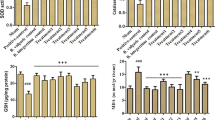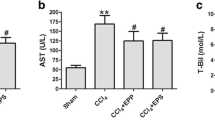Abstract
In recent years, chemical liver injury cases increased significantly in Asian countries, and the imbalance in redox system was believed to be the main cause. Purple sweet potato anthocyanins (PSPA) have been shown to exert antioxidant activity and oxidative-stress-associated functional protein modulation through various signaling pathways, so it is considered to have the potential of liver injury preventive activity. In order to evaluate the hepatoprotective potency of PSPA according to its free radical scavenging and antioxidant effects, three acute chemical liver injury models were set up with ethanol, acetaminophen and carbon tetrachloride. PSPA at moderate and high doses obviously attenuated the tested serum biomarker levels and liver index in our experiments. Besides, one chronic liver injury model set up with carbon tetrachloride was also applied, in which PSPA was orally administrated after the liver damage had been formed. Both the serum biomarker levels and histopathological analysis showed that PSPA was able to attenuated chronic liver injury. Our experimental results demonstrated the potential of PSPA as an oral hepatoprotective agent against chemical liver injury from food plant.






Similar content being viewed by others
References
Roušar, T., Nýdlová, E., Česla, P., Staňková, P., Kučera, O., Pařík, P., et al. (2012). Purified acetaminophen–glutathione conjugate is able to induce oxidative stress in rat liver mitochondria. Physiological Research, 61, S103–S109.
Nishikawa, M., Hashida, M., & Takakura, Y. (2009). Catalase delivery for inhibiting ROS-mediated tissue injury and tumor metastasis. Advanced Drug Delivery Reviews, 61, 319–326.
Liu, C., Zheng, G., Ming, Q., Sun, J., & Cheng, C. (2013). Protective effect of quercetin on lead-induced oxidative stress and endoplasmic reticulum stress in rat liver via the IRE1/JNK and PI3 K/Akt pathway. Free Radic Res., 47, 192–201.
Kim, H. R., & Kim, T. W. (2010). Occupational hepatic disorders in Korea. Journal of Korean Medical Science, S25, S36–S40.
Pimparkar, B. D., & Bhave, A. (2010). Arsenicosis: Review of recent advances. Journal of the Association of Physicians of India, 58, 617–624.
Wai, C. T., Tan, B. H., Chan, C. L., Sutedja, D. S., Lee, Y. M., Khor, C., et al. (2007). Drug-induced liver injury at an Asian center: A prospective study. Liver International, 27, 465–474.
Takayama, M., Fujisawa, M., Hori, Y., Oda, A., Katsuyama, S., Hirose, Y., et al. (2008). Clinical usefulness of the acetaminophen detection kit in treating acute poisoning—data from a survey of 28 cases treated at Niigata City general hospital. Yakugaku Zasshi, 128, 159–163.
Chirumbolo, S. (2010). The role of quercetin, flavonols and flavones in modulating inflammatory cell function. Inflammation & Allergy: Drug Targets, 9, 263–285.
Kim, H. P., Son, K. H., Chang, H. W., & Kang, S. S. (2004). Anti-inflammatory plant flavonoids and cellular action mechanisms. Journal of Pharmacology Science, 96, 229–245.
Agati, G., Azzarello, E., Pollastri, S., & Tattini, M. (2012). Flavonoids as antioxidants in plants: location and functional significance. Plant Science, 196, 67–76.
Deng, G. F., Xu, X. R., Zhang, Y., Li, D., Gan, R. Y., & Li, H. B. (2013). Phenolic compounds and bioactivities of pigmented rice. Critical Reviews in Food Science and Nutrition, 53, 296–306.
Seelinger, G., Merfort, I., & Schempp, C. M. (2008). Anti-oxidant, anti-inflammatory and anti-allergic activities of luteolin. Planta Medica, 74, 1667–1677.
Kokotkiewicz, A., Jaremicz, Z., & Luczkiewicz, M. (2010). Aronia plants: A review of traditional use, biological activities, and perspectives for modern medicine. Journal of Medicinal Food, 13, 255–269.
Bolling, B. W., Chen, C. Y., McKay, D. L., & Blumberg, J. B. (2011). Tree nut phytochemicals: composition, antioxidant capacity, bioactivity, impact factors. A systematic review of almonds, Brazils, cashews, hazelnuts, macadamias, pecans, pine nuts, pistachios and walnuts. Nutrition Research Reviews, 24, 244–275.
Dani, C., Oliboni, L. S., Pasquali, M. A., Oliveira, M. R., Umezu, F. M., Salvador, M., et al. (2008). Intake of purple grape juice as a hepatoprotective agent in Wistar rats. Journal of Medicinal Food, 11, 127–132.
Lebot, V. (2009). Tropical root and tuber crops-cassava, sweet potato, yams and aroids. Wallingford: CABI.
Bruinsma, Jelle. (2002). World Agriculture: Towards 2015/2030. An FAO Perspective. London: Earthscan Publications Ltd.
Kowalczyk, E., Krzesiński, P., Kura, M., Szmigiel, B., & Błaszczyk, J. (2003). Anthocyanins in medicine. Polish Journal of Pharmacology, 55, 699–702.
Kong, J. M., Chia, L. S., Goh, N. K., Chia, T. F., & Brouillard, R. (2003). Analysis and biological activities of anthocyanins. Phytochemistry, 64, 923–933.
Hwang, Y. P., Choi, J. H., Choi, J. M., Chung, Y. C., & Jeong, H. G. (2011). Protective mechanisms of anthocyanins from purple sweet potato against tert-butyl hydroperoxide-induced hepatotoxicity. Food and Chemical Toxicology, 49, 2081–2089.
Choi, J. H., Choi, C. Y., Lee, K. J., Hwang, Y. P., Chung, Y. C., & Jeong, H. G. (2009). Hepatoprotective effects of an anthocyanin fraction from purple-fleshed sweet potato against acetaminophen-induced liver damage in mice. Journal of Medicinal Food, 12, 320–326.
Hwang, Y. P., Choi, J. H., Han, E. H., Kim, H. G., Wee, J. H., Jung, K. O., et al. (2011). Purple sweet potato anthocyanins attenuate hepatic lipid accumulation through activating adenosine monophosphate-activated protein kinase in human HepG2 cells and obese mice. Nutr Res., 31, 896–906.
Kano, M., Takayanagi, T., Harada, K., Makino, K., & Ishikawa, F. (2005). Antioxidant activity of anthocyanins from purple sweet potato, Ipomoera batatas Cultivar Ayamurasaki. Bioscience, Biotechnology, and Biochemistry, 69, 979–988.
Gu, X., & Manautou, J. E. (2012). Molecular mechanisms underlying chemical liver injury. Expert Reviews in Molecular Medicine, 14, e4.
Liu, N., Wang, C., & Wang, S. (2008). Safety evaluation of sweet potato anthocyanins. Acta Academiae Medicinae Qingdao Universitatis, 44, 165–167.
Zhu, L., Han, Z., Yu, G., Meng, X., Han, Y., Wang, Z., et al. (2005). Protective effects of anthocyanin from Ipomoea Batatas on thymocytes irradiation damage caused by 60Co gama-ray in mice. Qilu Yixue Zazhi, 20, 380–384.
Meng, X., Chu, X., Wang, F., Cao, P., Liu, N., Wang, Z., et al. (2005). In vivo antioxidant activity of sweet potato anthocyanins in aged rats. Qilu Yixue Zazhi, 20, 394–399.
Liu, N., Wang, H., & Wang, C. (2008). Study on antitumor effect and its toxicity of Ipomoea Batatas Poir Cv anthocyanins. Wei Sheng Yan Jiu, 37, 489–491.
Ye, J., Meng, X., Yan, C., & Wang, C. (2010). Effect of purple sweet potato anthocyanins on beta-amyloid-mediated PC-12 cells death by inhibition of oxidative stress. Neurochemical Research, 35, 357–365.
Gutteridge, J., & Halliwell, B. (2000). Free radicals and antioxidants in the year 2000. A historical look to the future. Annals of the New York Academy of Sciences, 899, 136–147.
Ray, S. D., Lam, T. S., Rotollo, J. A., Phadke, S., Patel, C., Dontabhaktuni, A., et al. (2004). Oxidative stress is the master operator of drug and chemically-induced programmed and unprogrammed cell death: Implications of natural antioxidants in vivo. BioFactors, 21, 223–232.
Farinati, F., Piciocchi, M., Lavezzo, E., Bortolami, M., & Cardin, R. (2010). Oxidative stress and inducible nitric oxide synthase induction in carcinogenesis. Digestive Diseases, 28, 579–584.
Young, C. N., Koepke, J. I., Terlecky, L. J., Borkin, M. S., Boyd Savoy, L., & Terlecky, S. R. (2008). Reactive oxygen species in tumor necrosis factor-alpha-activated primary human keratinocytes: implications for psoriasis and inflammatory skin disease. Journal of Investigative Dermatology, 128, 2606–2614.
Lieber, C. S. (2005). Metabolism of alcohol. Clinics in Liver Disease, 9, 1–35.
Cederbaum, A. I. (2001). Introduction-serial review: Alcohol, oxidative stress and cell injury. Free Radical Biology & Medicine, 31, 1524–1526.
Lieber, C. S. (2004). Alcoholic fatty liver: Its pathogenesis and mechanism of progression to inflammation and fibrosis. Alcohol, 34, 9–19.
Arteel, G. E. (2003). Oxidants and antioxidants in alcohol-induced liver disease. Gastroenterology, 124, 778–790.
Nanji, A. A., Jokelainen, K., Rahemtulla, A., Miao, L., Fogt, F., Matsumoto, H., et al. (1999). Activation of nuclear factor kappa B and cytokine imbalance in experimental alcoholic liver disease in rat. Hepatology, 30, 934–943.
Cover, C., Mansouri, A., Knight, T. R., Bajt, M. L., Lemasters, J. J., Pessayre, D., et al. (2005). Peroxynitrite-induced mitochondrial and endonuclease-mediated nuclear DNA damage in acetaminophen hepatotoxicity. Journal of Pharmacology and Experimental Therapeutics, 315, 879–887.
Jaeschke, H., Knight, T. R., & Bajt, M. L. (2003). The role of oxidant stress and reactive nitrogen species in acetaminophen hepato-toxicity. Toxicology Letters, 144, 279–288.
Fujii, T., Fuchs, B. C., Yamada, S., Lauwers, G. Y., Kulu, Y., Goodwin, J. M., et al. (2010). Mouse model of carbon tetrachloride induced liver fibrosis: Histopathological changes and expression of CD133 and epidermal growth factor. BMC Gastroenterology, 10, 79.
Weber, L. W., Boll, M., & Stampfl, A. (2003). Hepatotoxicity and mechanism of action of haloalkanes: carbon tetrachloride as a toxicological model. Critical Reviews in Toxicology, 33, 105–136.
Pradhan, S. C., & Girish, C. (2006). Hepatoprotective herbal drug, silymarin from experimental pharmacology to clinical medicine. Indian Journal of Medical Research, 124, 491–504.
Acknowledgments
This work was supported by grants from Science and Technology Department of Shandong Province (Grant No. 2009GG10002070), grants from Qingdao Municipal Science and Technology Bureau (Grant No. 12-1-3-39_nsh) and grants from Shandong Provincial Natural Science Foundation (Grant No. ZR2010HL068).
Author information
Authors and Affiliations
Corresponding author
Additional information
Wencheng Wang and Jinlian Li have contributed equally to this work.
Rights and permissions
About this article
Cite this article
Wang, W., Li, J., Wang, Z. et al. Oral Hepatoprotective Ability Evaluation of Purple Sweet Potato Anthocyanins on Acute and Chronic Chemical Liver Injuries. Cell Biochem Biophys 69, 539–548 (2014). https://doi.org/10.1007/s12013-014-9829-3
Published:
Issue Date:
DOI: https://doi.org/10.1007/s12013-014-9829-3




